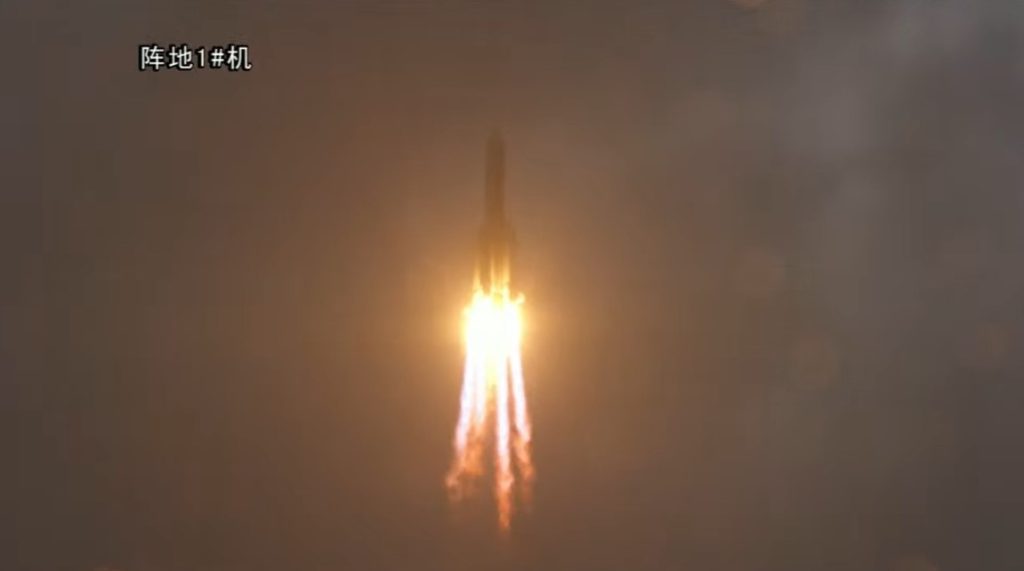China launched the complex and ambitious Chang’e-6 mission on Friday to collect the first samples from the far side of the moon.
A 57-meter-tall Long March 5 took off from the Wenchang Satellite Launch Center at 5:30 a.m. Eastern (0930 UTC) on May 3, carrying the roughly 8,200-kilogram Chang’e-6 into orbit.
The first second stage burn was finished 12 minutes after launch, with a translunar injection burn planned for about 14 minutes later. Spacecraft separation is set for around 37 minutes into the flight.
If successful, the samples brought back by the 53-day mission could change our understanding of the Earth and moon, as well as the history of the early solar system.
Chang’e-6 is made up of four spacecraft with specific roles. Its orbiter will take the mission into lunar orbit. After that, a lander will separate and aim for a landing within Apollo crater on the far side of the moon. A communications relay satellite is necessary to provide communications between the ground and the lunar far side, as the far side of the moon is not visible from Earth. For this purpose, China launched Queqiao-2 in March into a specialized lunar orbit. launched Queqiao-2 was launched in March. a specialized lunar orbit.
Once landed, the lander spacecraft will collect up to 2,000 grams of lunar samples with a drill, descending to a depth of up to two meters, and a scoop. These will be loaded into an ascent vehicle and launched back into lunar orbit for a carefully coordinated rendezvous and docking with the orbiter.
The samples will then be transferred to a reentry capsule. The ascender will be jettisoned and the orbiter will prepare for the return to Earth. The reentry capsule will be released just before reaching Earth and will first skip off the planet’s atmosphere. This will help it slow down before a final, fiery plunge through the atmosphere and a landing in Inner Mongolia.
The mission is a repurposed backup to the 2020 Chang’e-5 sample return mission, which successfully collected the youngest samples so far from the near side of the moon. It also builds on the Chang’e-4 mission, which put a lander and rover on the lunar far side in 2019.
Lunar mysteries and dichotomy
Apollo lies within the South Pole-Aitken (SPA) basin, a gigantic, ancient impact basin on the lunar far side. This holds fascinating clues about various moon mysteries, making the added cost of a relay satellite scientifically worthwhile.

The far side of the moon could provide unique insights. The samples could provide a vast range of insights into the Earth and moon, according to Yuqi Qian, a postdoctoral fellow at the University of Hong Kong. Chief among these would be insights into the lunar dichotomy, or why the nearside and farside are so different. Studying mare basalts could be revealing, Qian says, because they originated from the lunar mantle and contain crucial information about it. SpaceNews.
The SPA Basin easily dug up lunar mantle materials which might be found in Chang’e-6 samples. These are the best materials for studying the lunar magma ocean model because the lunar mantle comes directly from the solidification of the lunar magma ocean, which we have not had access to before.
Qian explains that studying unusual impact materials like impact breccias will also be informative about the history of the Earth-Moon system. By studying them, we would gain a better understanding of the early bombardment history of the Earth-Moon system, such as the Late Heavy Bombardment Hypothesis.
Chang’e-6 collaborations
In addition to collecting samples, the Chang’e-6 lander carries a landing camera and a panoramic camera to capture images of its surroundings. It also has a ground-penetrating radar to provide insights below the lunar surface, as well as a lunar mineral spectrometer to assess the surface composition. The spacecraft is also expected to place a Chinese national flag, similar to the Chang’e-5 lander.
A panorama captured by the Chang’e-5 lander, showing the robotic sampling arm and scoop marks in lunar regolith.

France is contributing the Detection of Outgassing RadoN instrument to detect radon outgassing from the lunar crust.
Sweden, with ESA support, will contribute the “Negative Ions at the Lunar Surface” payload.DORNAdditionally, an Italian passive laser retro-reflector will also be aboard. The 7-kg cubesat is a collaboration between Pakistan’s national space agency, SUPARCO, and China’s Shanghai Jiao Tong University.NILSChang’e-6 is part of China’s broader lunar objectives. The country will follow up with two missions to the south pole of the moon around 2028. Beyond this, the country aims to launch its first crewed lunar mission by 2030. Both sets of missions are part of a plan to establish a permanent lunar base known as the International Lunar Research Station (ILRS) program, planned for the 2030s. A number of countries and organizations have contributed to the project. ICUBE-Q Chang’e-6 will also provide experience of some of the operations and maneuvers needed to collect and return samples from Mars. China aims to launch such a mission around 2030.
China launched its complex and ambitious Chang’e-6 mission Friday to collect the first ever samples from the far side of the moon. Chang’e-7 in 2026 and Chang’e-8 around 2028.
Beyond this, the country aims to launch its first crewed lunar mission by 2030. Both sets of missions are part of a plan to establish a permanent lunar base. This project is known as the International Lunar Research Station (ILRS) program, planned for the 2030s. A number of countries and organizations have signed up to the project.
Chang’e-6 will also provide experience of some of the operations and maneuvers needed to collect and return samples from Mars. China aims to launch such a mission around 2030.









